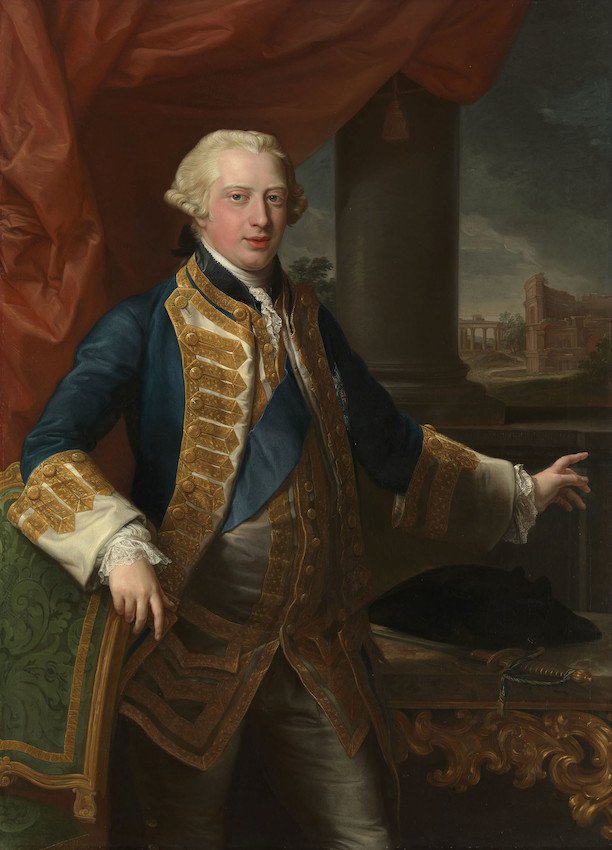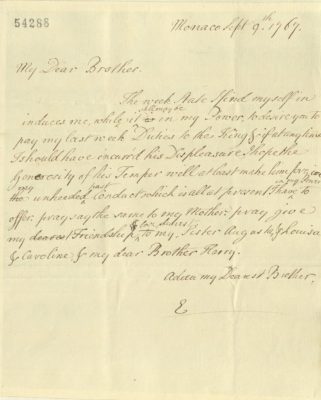
https://www.rct.uk/collection/405034/edward-duke-of-york-1739-1767 ©
The papers of Edward, Duke of York and Albany (1739-1767) are a modest collection of twenty four documents, comprised solely of correspondence. The majority of these letters were written before Prince Edward was bestowed the titles of Duke of York and Albany and Earl of Ulster in 1760, by his grandfather George II.
The second son and third child of Frederick, Prince of Wales and Augusta, Princess of Wales, the majority of the Duke of York’s letters are addressed to his elder brother, and constant childhood companion, Prince George, later George III. The easy informality of these records are evidence of their bond and upon his brother’s accession he was appointed a Privy Councillor. These candid letters include an interesting accusation by Thomas Potter in 1766 that George III was the father of his late wife’s child, ‘who only wants the name of Augustus to denote his origin’. The King writing to the Duke of York claimed Potter had obviously lost his senses by accusing the King of criminality and that all discourse should cease. In previous histories it has been stated that the Duke of York was the supposed father of the child rather than George III. However within these letters it is clear the accused was in fact the King, as he wrote to the Duke of York stating that he was not guilty of even the ‘very shadow of flurtation’. George III was defensive (whether justly or unjustly), and wrote in regards to Potter’s threats that, if he dared follow through, he would teach him that his ‘character is not to be abused without impunity’. Potter, trying to secure provision for the ‘little being’ had threatened to reveal all to vindicate himself, including the ‘melancholy catastrophe at Kew’ which would ‘be fatal & the ruin spread wider than you imagine’ (GEO/MAIN/54284-54285). Whether or not Potter was delusional is a matter for debate and future research.

Copy letter from Edward, Duke of York to Thomas Potter, 8 November 1766. RA GEO/MAIN/54284-54285 Royal Archives/© Her Majesty Queen Elizabeth II 2019
Many of Prince Edward’s letters detail his pursuits at sea. In 1758 he joined the navy as a volunteer, going to sea during the Seven Years War and serving aboard HMS Ramillies; from which the majority of correspondence is addressed. In these letters he includes the all-important weather conditions; movements of the British Fleet (including those which probably led to the battle of Quiberen Bay); meetings with naval officers; and intelligence regarding land battles involving Prussian, Russian, Austrian and British forces (possibly referencing the battles of Minden and Kunersdorf). He also describes travelling to meet his ship, including his entertainments (such as an assembly in Salisbury which ‘abounds in beauties’), and events (including his acceptance of the Freedom of the City of Exeter). After his experience aboard the Ramillies he became Captain of HMS Phoenix, rising to Rear Admiral in 1761, and finally appointed Vice Admiral in 1762. After his time with HMS Ramillies came to an end the correspondence dwindles, with only a few surviving letters from his later life, which may be a reflection of what was considered important by the recipients.

Copy letter from Edward, Duke of York, to William Henry, Duke of Gloucester, sent days before Edward’s death, 9 September 1767. Royal Archives/© Her Majesty Queen Elizabeth II 2019
During the 1760s, less interested in a naval career, the Duke travelled the continent extensively and it was whilst travelling to Genoa in 1767 that he succumbed to ‘maleary fever’ and died on 17 September 1767 in Monaco at the Palace of Honore III, Prince of Monaco. The final letter in this collection was written the day of the Duke’s death by Colonel St. John to inform the Duke’s brother, William Henry, Duke of Gloucester and Edinburgh, of his brother’s death that morning. Captain Convey would accompany his body back to Britain, and when Edward, Duke of York, was finally returned to British shores he was interred at Westminster Abbey on 3 November 1767.
Colonel St. John’s letter to the Duke of Gloucester was accompanied by another written by the Duke of York, possibly his final letter. This could potentially be GEO/MAIN/54288 a letter addressed to William Henry, Duke of Gloucester, dated 9 September 1767. In this letter, he knowingly sends his final respects to the Royal Family, and touchingly signs off for the last time ‘adieu my dearest brother, E’.
